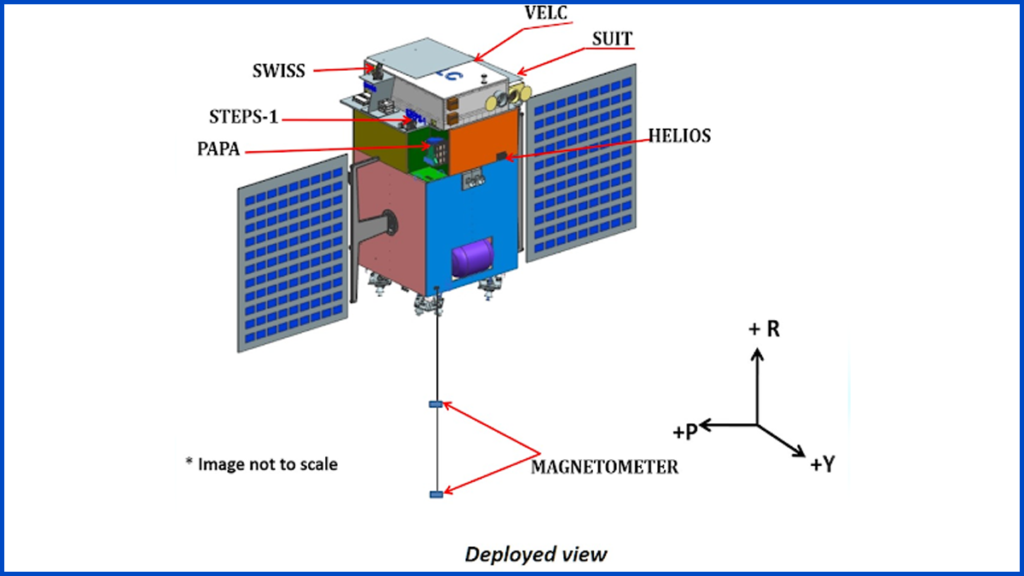Aditya L1 Mission: First Indian Mission To Study Sun By ISRO

Start with this burning question –
The temperature of the visible surface of the sun (photosphere):- 6,000 degrees celsius
But above a thousand kilometers from the photosphere, the corona temperature reaches – 10,00,000 degrees Celsius
What is the Mystery of this temperature inconsistency?
There are many such mysteries that the sun has contained in itself, even after so much technological and scientific advancement, we humans are unaware of them.
But now, To expose these mysteries, ISRO is planning to launch the Aditya L1 mission.
What is the Aditya L1 Mission?
In this mission, (Indian Space Research Organisation) ISRO plans to launch Aditya L1, a coronagraphy spacecraft, to study the solar atmosphere and corona of the sun.
It is being designed and developed by the Indian Space Research Organization (ISRO) and several other Indian research organizations.
The Aditya L1 mission takes its name from the Sanskrit name of the sun — Aditya — and the Lagrange point where it will place — L1 Lagrange point.
Aditya L1 is the first Indian dedicated mission to observe the sun, which is planned to be launched by the PSLV-XL launch vehicle.

What Is The Lagrange Point?
In simple words, the Lagrange point is an orbit type in the space between 2 bodies like the Sun and Earth, where the gravitational force of both the planets is balanced. And anything at these points is in a state of equilibrium.
And for this reason, if you place any satellite or spacecraft at these points, you need very little fuel consumption to move this because the body is free from any repulsion and attraction force.
That’s why you can also call it parking points of space.
Why ISRO Choose L1 Lagrange Point?
Lagrange points of Earth and Sun:-
| Lagrange Points | Distance from the Earth | Stability | Specifications |
| L1 | 1.5 million km | Unstable | This Offers uninterrupted views of Sun. |
| L2 | 1.5 million km | Unstable | The ideal location to study deep space. |
| L3 | 301.4 million km | Unstable | This is the Farthest lagrange point from the earth. |
| L4 | — | Stable | 60° ahead of earth, Where earth was 2 months ago |
| L5 | — | Stable | 60° behind of earth, Where earth will being 2 months time |

Payload Used In This Mission And Their Experiments
This satellite carries six payloads with additional science scope and objectives. And the final weight of the satellite will come to around 350 kg.
Institutes name and payloads :-
| Payload | Institute who developed |
| Visible Emission Line Coronagraph (VELC) | Indian Institute of Astrophysics (IIA) |
Solar Ultraviolet Imaging Telescope (SUIT) | Inter-University Centre for Astronomy and Astrophysics (IUCAA), PuneIndian Institute of Astrophysics (IIA), Center of Excellence in Space Sciences India (CESSI)-IISER Kolkata. |
| Aditya Solar wind Particle Experiment (ASPEX) | Physical Research Laboratory (PRL) |
| Plasma Analyser Package for Aditya (PAPA) | Space Physics Laboratory (SPL), VSSC |
| Solar Low Energy X-ray Spectrometer (SoLEXS) | ISRO Satellite centre (ISAC) |
| High Energy L1 Orbiting X-ray Spectrometer (HEL1OS) | High Energy L1 Orbiting X-ray Spectrometer (HEL1OS) |
| Magnetometer | Laboratory for Electro-Optics Systems (LEOS) and ISAC |
Objectives Of The Aditya L1 Mission
- The study of the dynamic nature of the sun’s outermost layers, the corona, and the chromosphere and gather information about coronal mass ejection (CME).
- Study on origin of solar flares and their direction via the interplanetary space from the sun to the earth.
- The examinations will also include the collection of data for space weather prediction.
Aditya L1 Launch Date
ISRO’s Aditya L1 mission is also postponed like other missions due to the Covid-19 pandemic, but now ISRO plans to launch it by September/October 2022.
Read Also:- India’s First Solar Mission Likely To Launch Next Year’: ISRO





